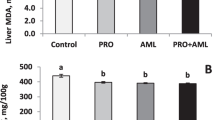Abstract
The aim of the study was to examine the effects of dry matter intake level and the feeding ofFusarium-contaminated wheat on the toxin-turnover and ruminal fermentation of dairy cows. Fourteen dairy cows equipped with ruminal and duodenal cannulae were used. All animals were fed the same diet, only the daily feed amounts were adjusted to the current performance stage of the cow. On a dry matter basis, the diet consisted of 60% concentrate including 55% wheat (Fusarium-contaminated wheat [Mycotoxin period] or control wheat [Control period]). Each cow was fed with both the contaminated and the control wheat. TheFusarium-contamination of the wheat significantly decreased the flow of undegraded protein at the duodenum with increased intakes of organic matter. The duodenal flow of microbial protein and the activities of aspartate aminotransferase (ASAT), glutamate dehydrogenase (GLDH) and gamma glutamyl transferase (γ-GT) in the serum were not affected by dietary treatment, but increased with feed intake. The duodenal flow of deoxynivalenol (DON) and de-epoxy DON related to DON intake ranged between 12 and 77% when theFusarium-contaminated wheat was fed. DON was almost completely metabolized to de-epoxy DON independent of the feed intake level. The zearalenone (ZON) flow at the duodenum increased moderately with increasing ZON/feed intake.
Similar content being viewed by others
References
Dänicke S, Matthäus K, Lebzien P, Valenta H, Ueberschär KH, Flachowsky G (2004) On the effects ofFusarium toxins on the fermentation and nutrient utilization in the rumen of dairy cows. Accepted by J anim Physiol Anim Nutr
Matthäus K, Dänicke S, Vahjen W, Simon O, Wang J, Valenta H, Meyer K, Strumpf A, Zieseniß H, Flachowsky G (2004) Progression of mycotoxin and nutrient concentrations in wheat after inoculation withFusarium culmorum. Arch Anim Nutr 58: 19–35
Kang Z, Buchenauer H (2000) Ultrastructural and cytochemical studies on cellulose, xylan and pectin degradation in wheat spikes infected byFusarium culmorum. J Phytopathol 148: 263–275
Author information
Authors and Affiliations
Corresponding author
Rights and permissions
About this article
Cite this article
Seeling, K., Dänicke, S., Lebzien, P. et al. On the effects ofFusarium-contaminated wheat and the feed intake level on ruminal fermentation and toxin-turnover of cows. Mycotox Res 21, 132–135 (2005). https://doi.org/10.1007/BF02954437
Issue Date:
DOI: https://doi.org/10.1007/BF02954437




